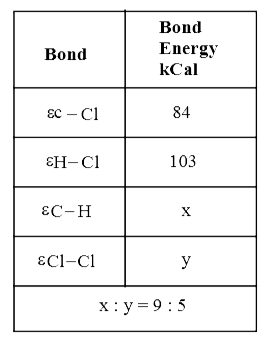In the radical chlorination of methane, one propagation step in shown as Cl⋅+CH4→HCl+⋅CH3
Why do we eliminate the possibility that this step goes as shown below?
Cl⋅+CH4→CH3Cl+H⋅
Because in the next propagation step, H⋅ would have to react with Cl2 to form Cl⋅andHCl⋅, this reaction is not feasible.
Because this alternative step has a more endothermic ΔH∘ than the first
Because free hydrogen atoms cannot exist
Because this alternative step is not consistent with the high photochemical efficiency of this reaction
The correct Answer is:B
Topper's Solved these Questions
- RADICAL REACTIONSBOOK - MS CHOUHANCHAPTER - RADICAL REACTIONSEXERCISE - Additional Objective Questions (Integer Type)
4 Videos
- RADICAL REACTIONSBOOK - MS CHOUHANCHAPTER - RADICAL REACTIONSEXERCISE - Additional Objective Questions (Matrix Match Type)
6 Videos
- RADICAL REACTIONSBOOK - MS CHOUHANCHAPTER - RADICAL REACTIONSEXERCISE - Practice Problem
2 Videos
- PRACTICAL ORGANIC CHEMISTRYBOOK - MS CHOUHANCHAPTER - PRACTICAL ORGANIC CHEMISTRYEXERCISE - Level 2
5 Videos
- REACTION OF AROMATIC COMPOUNDS BOOK - MS CHOUHANCHAPTER - REACTION OF AROMATIC COMPOUNDS EXERCISE - ADDITIONAL OBJECTIVE QUESTIONS (MULTIPLE CORRECT CHOICE TYPE)
2 Videos
Similar Questions
Knowledge Check
What type of reaction is shown below ?
CH4+Cl2Sunlight−−−−→CH3−Cl+HClAAdditionBSubstitutionCDecompositionDReductionSlect the chain propagation steps in the free-radical chlorination of methane.
1. Cl2→2Cl⋅
2. Cl⋅+CH4→CH3Cl+H⋅
3. Cl⋅+CH4→CH⋅3+HCl
4. H⋅+Cl2→HCl+Cl⋅
5. CH⋅3+Cl2→CH3Cl+Cl⋅A2, 3, 5B1, 3, 6C3, 5D2, 3, 4Select the chain propagation steps in the free-radical chlorination of methane.
(1) Cl2→2Cl⋅ (2) Cl⋅+CH4→CH3Cl+H⋅
(3) Cl⋅+CH4→CH⋅3+HCl (4) H⋅+Cl2→HCl+Cl⋅
(5) CH⋅3+Cl2→CH3Cl+Cl⋅A2,3,5B1,3,6C3,5D2,3,4
Identify the type of the following reaction of carbon compounds.
CH3−CH3+Cl2→CH3−CH2−Cl+HCl
View SolutionCH3Cl→CH4
Above conversion can be achieved by :
View SolutionCH4+Cl2→CH3Cl+HCl the reaction is
View SolutionThe reaction CH4(g)+Cl2(g)→CH3Cl(g)→HCl(g) has ΔH=−25kCal .

From the given data , what is the bond energy of Cl – Cl bond
View SolutionWhich step is chain propagation step in the following mechanism ?
(i) Clhv−−→Cl.+Cl.
(ii) Cl.+CH4→.CH3+HCl
(iii) Cl.+Cl.→Cl2
(iv) CH3+.Cl→CH3Cl
View Solution
